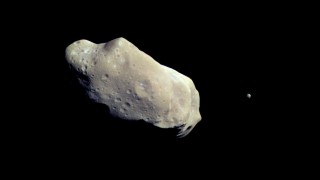
An asteroid is scheduled to pass close to Earth on Monday, and astronomers are calling it one of the biggest asteroids seen. It is believed the rock tumbling through space is about two thousand feet wide, which is about the size of a mountain. Due to that dimension, astronomers are saying people should be able to view it from their own backyards, with the assistance of binoculars or telescopes.
The asteroid has been labeled as 2004 BL86 and will flyby around 745,000 miles from the Earth. That is approximately three times the distance of the moon according to Fox News. Such a distance might not sound like a close call, but when reviewed from an expert viewpoint, that is basically missing the Earth by the width of a finger nail. A good example to use is the distance between Earth and Mars. The two are considered to be close neighbors, yet Mars is almost 150 lunar distances away. That is about 50 times the distance of this asteroid.
Numerous astronomers and scientists all over the world plan on keeping a close eye on the huge rock. It offers an excellent chance for them to get a very close look at this near-Earth asteroid that will not come by again until the year 2027.
Astronomers are anxious to get to take a look at 2004 BL86 because they want to attempt to isolate its orbit, and track the quick moving asteroid by using a dish-shaped antenna, which is located at NASA’s Deep Space Network in California. They want to look at its surface and even search for existing moons if there are any.
Dr. Lance Benner, a well respected astronomer who works at NASA’s Space Laboratory, said for asteroids that fly so close and are as big, radar observations are really similar to a spacecraft flying by in relation to the quality of the information astronomers are able to get.
Any resulting black-and-white photographs can divulge unique particulars about asteroids, where the majority of ground based telescopes would pick up only a pin point of light. Dr. Benner added that just because 2004 BL86 does not pose a threat to Earth this time around, it just makes sense to keep a watch on the asteroid. He explained that it was basically a type of insurance to observe these rocks on an ongoing basis.
Experts in the industry also share this specific asteroid belongs to a cluster of 551 known near-Earth asteroids that are considered to have the possibility of impacting the Earth sometime in the future. Fortunately, 2004 BL86 does not appear to have the Earth’s number just yet.
The scientists are hoping to acquire resolutions as close as almost 12 feet per pixel, so the imaginings of 2004 BL86 ought to reveal details as tiny as the size of a normal car. It should also allow astronomers to be able to evaluate just how jagged or smooth the surface of the space rock is.
Some people may wonder why this is important and Dr. Carol Raymond, who is the principal investigator with NASA’s Dawn mission, explained that by studying asteroids it helps scientists to discover more about the building blocks of various planets.
In addition, if Dr. Benner and his group are able to obtain enough images as the asteroid rotates when it is flying by the Earth, they may be able to rebuild its three dimensional form in order to better figure out just how it revolves. They also want to look for any tiny moons that may be in tow. Around 16 percent of asteroids in 2004 BL86’s size tend to have smaller objects following along with them.
Image Credit - NASA
